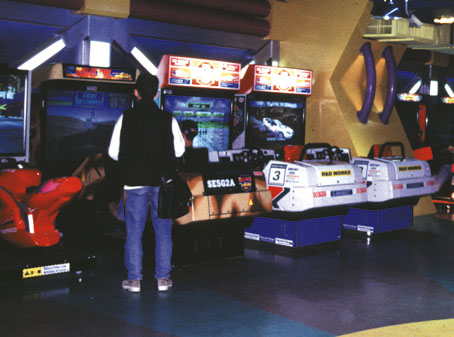 Faking it
Faking itVirtual reality lets people explore brave new worlds



 Faking it
Faking it
Virtual reality lets people
explore brave new worlds
By Mimi Lok
Such things are possible through virtual reality.
Virtual reality combines computer graphics and sound in computer software. It provides a sense of realism through interacting with an artificial three-dimensional environment combining the use of computer-aided devices.
The idea of virtual reality was first initiated in America. In the 1960s, a filmmaker in America wanted to produce a film with genuine senses such as smell and taste to audience. The plan finally failed, but this idea stimulated the development of virtual reality.
There are two levels of virtual reality. Fly-through virtual reality allows users to navigate but not to interact with objects in the virtual environment. While in reactive reality, users can touch and manipulate the virtual objects as well.
In order to introduce this new technology, the Hong Kong Science Museum held an exhibition in April.
“Virtual reality is different from pure computer graphics. The world is generated with the complement of sound. It provides a 3-D visual environment,” said Mr. Chan Ki Hung, assistant curator of the Hong Kong Science Museum.
“We here offer three kinds of virtual reality for visitors in the exhibition. One is the Venturer Simulator, which was installed in the museum quite a long time ago. It provides a high degree of reactivity.
“Users sit in a spaceship-like machine. By mixing computer graphics and sound, they sense a 3-D world,” said Mr. Chan.
Turbo Kourier is another system. It seems to free people from physical constraints. The movements of the participant’s body direct the computer.
A video camera captures people’s images which are then combined with an interactive computer-generated virtual world. Hence, waving one’s hands will create a beautiful graphic pattern, or making a kick will change the course of a shooting ball.
“Turbo Kourier can put you on a flying skateboard in the streets of a future city. Or, in soccer game, you can act as a goalkeeper and balls will be coming at you from all directions. If you love music, you can create your own musical performance with a series of musical instruments,” said Mr. Chan.
Another technology requires the aid of a head-mounted display and a hand-held input device. Users are transported into a 3-D environment. Putting on the head-mounted display, they see a different 3-D environment with six degrees of freedom in which the physical world is totally ignored.
“Virtual reality is not restricted to entertainment areas. It provides environment for practical exercises. It enables pilots taking flying lessons without leaving the ground. Some doctors are performing virtual surgery without going into operating room. Some physicians are entering virtual reality to try out medical equipment .
“But its limitation is time delay. When you drop a cup in the artificial world, the sound made comes two seconds later,” said Mr. Chan.
Said Mr. Kelvin Joan, another assistant curator of the Hong Kong Science Museum: “All the games are created by computer graphics, and they are totally different from our real world. The sense of 3-D is acceptable, but it is very tiring to look at the head-mounted display for a long period.
“But I enjoy the extra space it gives me. I enjoy the personal space with little noise. I love that!” Mr. Joan said.
Many corporations also regard virtual reality as a cheap and effective way to increase sales and to train employees.
American fast food chain Burger King held a show that allowed audience to don a pair of “Stereographic Crystal Eyes” and navigate through the virtual restaurant of the future from the perspective of a customer or an employee.


